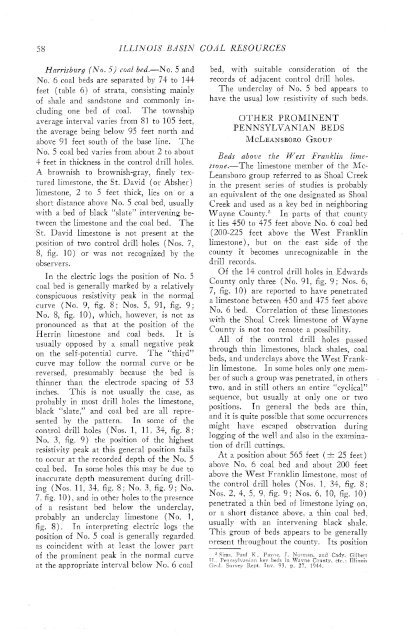subsurface geology and coal resources of the pennsylvanian system ...
subsurface geology and coal resources of the pennsylvanian system ...
subsurface geology and coal resources of the pennsylvanian system ...
You also want an ePaper? Increase the reach of your titles
YUMPU automatically turns print PDFs into web optimized ePapers that Google loves.
58 ILLINOIS BASIAT COAL RESOURCES<br />
Harrisburg (No. 5) <strong>coal</strong> bed.-No. 5 <strong>and</strong><br />
No. 6 <strong>coal</strong> beds are separated by 74 to 131<br />
feet (table 6) <strong>of</strong> strata, consisting mainly<br />
<strong>of</strong> shale <strong>and</strong> s<strong>and</strong>stone <strong>and</strong> commonly including<br />
one bed <strong>of</strong> <strong>coal</strong>. The township<br />
average interval varies from 81 to 105 feet,<br />
<strong>the</strong> average being below 95 feet north <strong>and</strong><br />
above 91 feet south <strong>of</strong> <strong>the</strong> base line. The<br />
No. 5 <strong>coal</strong> bed varies from about 2 to about<br />
4 feet in thickness in <strong>the</strong> control drill holes.<br />
A brownish to brownish-gray, finely textured<br />
limestone, <strong>the</strong> St. David (or Absher)<br />
limestone, 2 to 5 feet thick, lies on or a<br />
short distance above No. 5 <strong>coal</strong> bed, usually<br />
with a bed <strong>of</strong> black "slate" intervening between<br />
<strong>the</strong> limestone <strong>and</strong> <strong>the</strong> <strong>coal</strong> bed. The<br />
St. David limestone is not present at <strong>the</strong><br />
position <strong>of</strong> two control drill holes (Nos. 7,<br />
8, fig. 10) or was not recognized by <strong>the</strong><br />
observers.<br />
In <strong>the</strong> electric logs <strong>the</strong> position <strong>of</strong> No. 5<br />
<strong>coal</strong> bed is generally marked by a relatively<br />
conspicuous resistivity peak in <strong>the</strong> normal<br />
curve (No. 9, fig. 8; Nos. 5, 91, fig. 9;<br />
No. 8, fig. lo), which, however, is not as<br />
pronounced as that at <strong>the</strong> position <strong>of</strong> <strong>the</strong><br />
Herrin limestone <strong>and</strong> <strong>coal</strong> beds. It is<br />
usually opposed by a small negative peak<br />
on <strong>the</strong> self-potential curve. The "third"<br />
curve may follow <strong>the</strong> normal curve or be<br />
reversed, presumably because <strong>the</strong> bed is<br />
thinner than <strong>the</strong> electrode spacing <strong>of</strong> 53<br />
inches. This is not usually <strong>the</strong> case, as<br />
probably in most drill holes <strong>the</strong> limestone,<br />
black "slate," <strong>and</strong> <strong>coal</strong> bed are all represented<br />
by <strong>the</strong> pattern. In some <strong>of</strong> <strong>the</strong><br />
control drill holes (Nos. 1, 11, 34, fig. 8 ;<br />
No. 3, fig. 9) <strong>the</strong> position <strong>of</strong> <strong>the</strong> highest<br />
resistivity peak at this general position fails<br />
to occur at <strong>the</strong> recorded depth <strong>of</strong> <strong>the</strong> No. 5<br />
<strong>coal</strong> bed. In some holes this may be due to<br />
inaccurate depth mea-surement during drilling<br />
(Nos, 11, 31, fig. 8; No. 3, fig. 9; No.<br />
7, fig. lo), <strong>and</strong> in o<strong>the</strong>r holes to <strong>the</strong> presence<br />
<strong>of</strong> a resistant bed below <strong>the</strong> underclay,<br />
probably an underclay limestone (No. 1,<br />
fig. 8). In interpreting electric logs <strong>the</strong><br />
position <strong>of</strong> No. 5 <strong>coal</strong> is generally regarded<br />
as coincident with at least <strong>the</strong> lower part<br />
<strong>of</strong> <strong>the</strong> prominent peak in <strong>the</strong> normal curve<br />
at <strong>the</strong> appropriate interval be lo^ No. 6 <strong>coal</strong><br />
bed, with suitable consideration <strong>of</strong> <strong>the</strong><br />
records <strong>of</strong> adjacent control drill holes.<br />
The underclay <strong>of</strong> No. 5 bed appears to<br />
have <strong>the</strong> usual low resistivity <strong>of</strong> such beds.<br />
OTHEK PROMINENT<br />
PENNSYLVANIAN BEDS<br />
Beds abozle <strong>the</strong> West Franklin limestone.-The<br />
limestone member <strong>of</strong> <strong>the</strong> R4c-<br />
Leansboro group referred to as Shoal Creek<br />
in <strong>the</strong> present series <strong>of</strong> studies is probably<br />
an equivalent <strong>of</strong> <strong>the</strong> one designated as Shoal<br />
Creek <strong>and</strong> used as a key bed in neighboring<br />
Wayne County.Vn parts <strong>of</strong> that county<br />
it lies 350 to 475 feet above No. 6 <strong>coal</strong> bed<br />
(200-225 feet above <strong>the</strong> West Franklin<br />
limestone), but on <strong>the</strong> east side <strong>of</strong> <strong>the</strong><br />
county it becomes unrecognizable in <strong>the</strong><br />
drill records.<br />
Of <strong>the</strong> 14 control drill holes in Edwards<br />
County only three (No. 9 1, fig. 9 ; Nos. 6,<br />
7, fig. 10) are reported to have penetrated<br />
a limestone between 450 <strong>and</strong> 475 feet above<br />
No. 6 bed. Correlation <strong>of</strong> <strong>the</strong>se limestones<br />
with <strong>the</strong> Shoal Creek limestone <strong>of</strong> Wayne<br />
County is not too remote a possibility.<br />
All <strong>of</strong> <strong>the</strong> control drill holes passed<br />
through thin limestones, black shales, <strong>coal</strong><br />
beds, <strong>and</strong> wnderclays above <strong>the</strong> West Franklin<br />
limestone. In some holes only one member<br />
<strong>of</strong> such a group was penetrated, in o<strong>the</strong>rs<br />
two, <strong>and</strong> in still o<strong>the</strong>rs an entire "cyclical"<br />
sequence, but usually at only one or two<br />
positions. In general <strong>the</strong> beds are thin,<br />
<strong>and</strong> it is quite possible that some occurrences<br />
might have escaped observation during<br />
logging <strong>of</strong> <strong>the</strong> well <strong>and</strong> also in <strong>the</strong> examination<br />
<strong>of</strong> drill cuttings.<br />
At a position about 565 feet (t 25 feet)<br />
above No. 6 <strong>coal</strong> bed <strong>and</strong> about 200 feet<br />
above <strong>the</strong> West Ft-gnklin limestone, most <strong>of</strong><br />
<strong>the</strong> control drill holes (Nos. 1, 34, fig. 8 ;<br />
Nos. 2, 4, 5, 9, fig. 9; Nos. 6. 10, fig. 10)<br />
penetrated a thin bed <strong>of</strong> limestone ly' llng on,<br />
or a short distance above, a thin <strong>coal</strong> bed,<br />
usually with an intervening black shale.<br />
This grour, <strong>of</strong> beds appears to be generally<br />
nresent throughout <strong>the</strong> county. Its position<br />
*' Sims, Paul K.. Pane. T. Norman. 3rd Cady. Gilbert<br />
TT.. Pennsylvanian key beds in Wavne County, etc.: Illinois<br />
Crr1;l. Survey Rept. Inv. 93. p. 27, 1941.
















